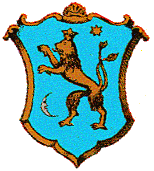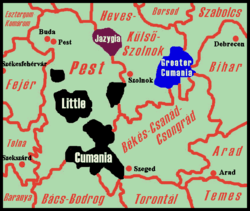Kunság
- This article deals with the region of Cumania in Hungary. For other regions of the same name, see Cumania.


Kunság is a historical and geographical region in Hungary situated in the current Bács-Kiskun and Jász-Nagykun-Szolnok counties. Like other historical European regions called Cumania, it is named for the Cumans, a nomadic tribe who formed a confederation with the Kipchaks that settled the area. It is divided into Greater Cumania and Little Cumania.
Ethnic affiliations and genetic origins
In a study by Bogacsi-Szabo, Erika. et al. (2005) of the mtDNA (Mitochondrial DNA) of the Cuman nomad population that migrated into the Carpathian basin during the 13th century, six haplogroups were revealed. "One of these haplogroups belongs to the M lineage (haplogroup D) and is characteristic of Eastern Asia, but this is the second most frequent haplogroup in southern Siberia too. All the other haplogroups (H, V, U, U3, and JT) are West Eurasian, belonging to the N macrohaplogroup. Out of the eleven remains, four samples belonged to haplogroup H, two to haplogroup U, two to haplogroup V, and one each to the JT, U3, and D haplogroups. Modern Hungarian samples represent 15 haplogroups. All but one is a West Eurasian haplogroup [the remaining one is East Asian (haplogroup F)], but all belong to the N lineage. Four haplogroups (H, V, U*, JT), present in the ancient samples, can also be found in the modern Hungarians, but only for haplogroups H and V were identical haplotypes found. Haplogroups U3 and D occur exclusively in the ancient group, and 11 haplogroups (HV, U4, U5, K, J, J1a, T, T1, T2, W, and F) occur only in the modern Hungarian population. Haplogroup frequency in the modern Hungarian population is similar to other European populations, although haplogroup F is almost absent in continental Europe; therefore the presence of this haplogroup in the modern Hungarian population can reflect some past contribution."[1]
"The results suggested that the Cumanians, as seen in the excavation at Csengele, were far from genetic homogeneity. Nevertheless, the grave artifacts are typical of the Cumanian steppe culture; and five of the six skeletons that were complete enough for anthropometric analysis appeared Asian rather than European (Horváth 1978, 2001), including two from the mitochondrial haplogroup H, which is typically European. It is interesting that the only skeleton for which anthropological examination indicated a partly European ancestry was that of the chieftain, whose haplotype is most frequently found in the Balkans."[2]
History

Prior to their entry into the Kingdom of Hungary, the Cumans inhabited the vast areas of the Pontic-Caspian steppe, where they had created a powerful nomadic confederacy (see Cumania). In the 13th century, they were attacked and defeated by the Mongol Empire after which most of them fled to Hungary, the Bulgarian Empire, and the Byzantine Empire.
The first Cumans arrived in Hungary in 1239 but there was violence between the nomadic Cumans and the settled Hungarians. Hungarians murdered the Cuman leader Kuthen (Kötöny) and the Cumans fled to the Balkans in 1241, pillaging as they went.
Following the Mongol invasion of Hungary in 1246, King Béla IV, invited 40 to 60 thousand Cumans and smaller group of Jazyges back to Hungary to settle in areas of the Great Hungarian Plain depopulated by Mongol invasions that would beceome Kunság and Jazygia. An area between Szolnok and Debrecen became Greater Cumania (Nagykunság) while an area between the Kalocsa and Szeged became Little Cumania (Kiskunság).
In exchange for military service to the Hungarian king against the Mongols, the Cumans were allowed to keep their own ethnic customs but they were required to settle permanently and convert to Christianity. Bela bethrothed his son Stephen to Kuthen's daughter Elizabeth. In 1279, King Ladislaus IV formalized Cuman territorial autonomy in Kunság.
Following the Ottoman occupation of much of Hungary in the 16th century, the region was part of the Jazygia-Cumania (Jászkunság) District which lay outside the Kingdom of Hungary's county system.

The 1711 Peace of Szatmár following the Rákóczi Uprising abolished the privileges of the Cumans and Jazyges but Jazygia-Cumania was restored by Maria Theresa of Austria in 1745. The territories possessed greater rights than the counties of Hungary including the freedom from villeinage (serfdom) well before its abolition throughout Hungary in 1858.
Cuman autonomy had been revoked and restored several times over the centuries, but in 1876 the territories were permanently abolished and incorporated into the county system as part of the Jász-Nagykun-Szolnok and Pest-Pilis-Solt-Kiskun counties.
Language and population
After settling in Kunság, the Cumans continued to practice nomadic of animal husbandry and lived in felt-covered yurts. By the end of the 14th century, the Cumans had begun to settle in villages and were gradually assimilating into Hungarian ways. The wars and Ottoman invasion in the 16th century disrupted the social structure of the region, but the Cumans returned to the areas and kept some of their native social customs.
The Turkic Cuman language was still spoken at the time of the Ottoman occupation and during the Protestant Reformation but it died out in Hungary by the middle of the 17th century and its traces can only be found in placenames.
See also
- Greater Cumania
- Little Cumania
- Jazygia
- Cumania
- Cumans
- Administrative divisions of the Kingdom of Hungary
- Seat (territorial-administrative unit)
Notes
- ↑ "Mitochondrial DNA of Ancient Cumanians: Culturally Asian Steppe Nomadic Immigrants with Substantially More Western Eurasian Mitochondrial DNA Lineages". Human Biology. 2005. pp. 639–662.
- ↑ "Mitochondrial DNA of Ancient Cumanians: Culturally Asian Steppe Nomadic Immigrants with Substantially More Western Eurasian Mitochondrial DNA Lineages". Human Biology. 2005. pp. 639–662.
